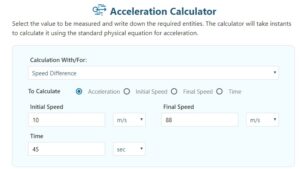A moving object is said to be accelerated when there is a particular change in its velocity. The change in the velocity of an object can increase or decrease in speed or a change in the direction of motion. In simple words, we can say that the rate of change of velocity with time in terms of both speed and motion. The falling of an apple on the floor, the moon orbiting around the earth, or a vehicle stopped at the traffic lights are some examples of acceleration. Therefore, we conclude that when there is a change in direction of a moving object or an increase or decrease in speed, acceleration takes place. A free online acceleration calculator helps to find the rate of change in the velocity of an object.
Brief Explanation about Acceleration:
In physics, the term acceleration is explained as the rate at which the moving object changes its velocity in a specific period of time. Generally, it is a vector quantity and contains both direction and magnitude. The object is accelerated when the velocity changes. According to Newton’s second law, acceleration is proportional to the force that acts on the object.

What is the Acceleration Formula?
You can use the acceleration equation or formula to determine acceleration. Here we discuss the acceleration formula and is given as:
a=Δv/Δt
Where Δv indicates the change in velocity and Δt represents the change in time.
And, acceleration equation can also be written as:
a=v(f)−v(i)/t(f)−t(i)
In this acceleration equation,
- v(f) is the final velocity
- v(i) is the initial velocity.
- t(f) is the final time
- t(i) is the initial time calculator
However, this free online acceleration calculator finds the results according to the above formula. Therefore, the tool gives accurate calculations.
SI unit:
The unit that indicates the acceleration is m/s^2.
Types of acceleration:
There are distinct types of acceleration that include:
- Uniform acceleration
- Non-uniform acceleration
- Instantaneous acceleration.
How to use an Acceleration Calculator?
This acceleration calculator is simple and easy to use for everyone. You have to follow the given below steps:
Step #1:
First, select the parameter that you want to calculate
Step #2:
After that, select the option for calculating.
Step #3:
Now enter the value in the designated area of the tool
Step #4:
Finally, click the “Calculate” button
Step #5:
The calculator does the following results:
- Initial and final Velocity from acceleration
- Constant Acceleration and time of an object
- It calculate the displacement of an object
- It determine the average Velocity of an object
- It displays the plot Graph Velocity(m/s) vs. Time(s)
- It displays the plot Graph Displacement(m) vs. Time(s)
Example:
A car is moving with a constant velocity, v = 5 m.s-1. The driver stops for petrol and the car accelerates forward. After 20 seconds, the driver stops accelerating to keep a constant velocity, v = 25 m.s-1. How to find the acceleration of the car?
Solution:
Initial velocity, vi = 5 m.s-1
Final velocity, vf = 25 m.s-1
Time interval, t = 20 s
∴ By the definition, acceleration is given as:
a=v(f)−v(i)/t
= 25-5/20
= 1m/s^2
Conclusion:
Acceleration plays an important role in the field of physics. It has the ability to indicate the rate of change of velocity of an object or in a specific distance. Therefore, it tells the distance covered by an object in terms of time. A free online acceleration calculator is the best choice to calculate the rate of change of velocity.





